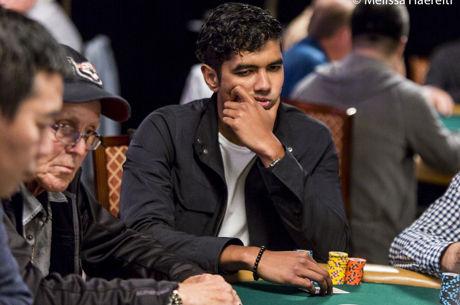Overbetting the River Against Capped Ranges

I recently wrote an article where I studied the bet sizing used by the players in the final $100,000 buy-in Poker Masters tournament held last month at the ARIA Resort & Casino. There I noticed that the players' bet sizing in this event was significantly different from the sizing typically used in the small stakes games I play.
In that discussion I focused on continuation bet sizing, in particular noting the differences between continuation betting in position and out of position. This week, I want to add to my analysis of the river overbets that were made at that final table.
The main takeaway from the river overbetting I observed in the $100,000 Poker Masters is that the elite players tended to use overbets on the river when they arrived there with only a small number of value combos possible. When this happened, their opponent would have a hard time putting them on a hand and so they would be looking for reasons to bluff catch.
In these cases, the overbet was necessary to make that decision about whether or not to bluff catch more difficult. In order to remain balanced, these players would choose the best bluffing combos to put into their overbetting range as well. This resulted in them betting with an extremely polarized range that can be hard to play against when it is balanced in this way.
While discussing this concept with me, Andrew Brokos pointed out that I was primarily discussing the mechanics of constructing an overbetting range and not the reasoning for making the overbet in the first place.
Andrew said it mattered less that the hero arrived at the river with only a small number of value combos possible, but more so that the villain had a capped range. Only then does it make sense to employ an overbet. After you've come to that conclusion, you would then begin to construct the overbetting range by filling it with your best value hands and your best bluffs. There was a good example of this concept at the final table.
There were six players left. With the blinds 10,000/25,000, Christian Christner opened A?A? from the cutoff to 55,000. Steffen Sontheimer (pictured above) defended in the big blind with 10?9?. The flop came 5?4?3? and went check-check. The turn brought the 7?, and Sontheimer led with a bet of 55,000 into pot of 145,000. Christner called.
The 6? landed on the river putting a straight on the board. Sontheimer then overbet 315,000 into a pot of 255,000 to try and bluff Christner off of a chop.

When Christner declined to continuation bet the flop or raise the small bet on the turn, he capped his range at one pair. If he had better than one pair, he likely would not have taken this passive line. Meanwhile having just defended the big blind and bet the turn, Sontheimer's range was uncapped meaning he could more easily have had an 8x in his hand for a bigger straight on this river than Christner.
My understanding of this spot is that because Sontheimer could have had an eight here, it was a good time for an overbet. But this is only half the story. To Andrew's point, the real reason for this overbet was not because Sontheimer could have had an eight, but because Christner was unlikely to have one.
Sontheimer was even more confident that this was the case because he held 10?9? which blocked both 10?8? and 9?8? �� two of the most likely combinations from Christner's opening range that would have contained an eight.
It is easy to see why Sontheimer chose to bluff with this hand. I am confident that he would have chosen the same sizing if he actually held an eight as well.
Next week, I will wrap up this series by examining the different preflop three-bet sizing that took place at that $100,000 Poker Masters final table.









